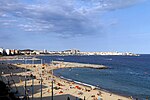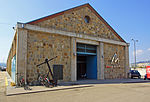Sant Feliu de Guíxols

Sant Feliu de Guíxols in Catalan or San Felíu de Guixols in Spanish, is a municipality in the comarca of the Bajo Ampurdán in Catalonia, Spain. It is situated on the Costa Brava and is an important port and tourist centre. The district abuts to the north, the upmarket s'Agaró resort built round the Sant Pol Beach. In addition to tourism and the port the cork industry is a traditionally local industry. The town contains a large monastery which now houses the town museum and is a protected historico-artistic monument. The C-253 road runs north near the coast from Sant Feliu de Guíxols to Platja d'Aro and Palamós, while the C-65 road runs inland from the town. The GI-682 provides a dramatic cliff top drive to Tossa de Mar to the south.Sant Feliu de Guíxols is a staging point on the GR 92 long-distance footpath, which runs the length of the Mediterranean coast of Spain. Stage 9, to the north, closely follows the coast via S'Agaró, Platja d'Aro and Sant Antoni de Calonge to the next staging point at Palamós, a distance of 16.8 kilometres (10.4 mi). Stage 10, to the south, takes a largely inland route to the next staging point at Tossa de Mar, a distance of 20.2 kilometres (12.6 mi).
Excerpt from the Wikipedia article Sant Feliu de Guíxols (License: CC BY-SA 3.0, Authors, Images).Sant Feliu de Guíxols
Travessia de Sant Isidre,
Geographical coordinates (GPS) Address Nearby Places Show on map
Geographical coordinates (GPS)
| Latitude | Longitude |
|---|---|
| N 41.783333333333 ° | E 3.0333333333333 ° |
Address
Travessia de Sant Isidre
Travessia de Sant Isidre
17220
Spain
Open on Google Maps








